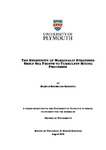The Sensitivity of Marginally Stratified Shelf Sea Fronts to Turbulent Mixing Processes
| dc.contributor.supervisor | Hosegood, Philip | |
| dc.contributor.author | Zanacchi, Marcus | |
| dc.contributor.other | School of Biological and Marine Sciences | en_US |
| dc.date.accessioned | 2019-09-11T15:07:48Z | |
| dc.date.available | 2019-09-11T15:07:48Z | |
| dc.date.issued | 2019 | |
| dc.date.issued | 2019 | |
| dc.identifier | 10146887 | en_US |
| dc.identifier.uri | http://hdl.handle.net/10026.1/14910 | |
| dc.description.abstract |
Turbulent mixing plays an important role in controlling the vertical structure of temperature, salinity and density in shelf seas. It is crucial in controlling the seasonal stratification in temperate shelf seas, though our incomplete knowledge of the processes involved prevents an accurate representation in numerical shelf sea modelling. This study made use of both observational field work and numerical turbulence modelling to identify first- and second-order mixing mechanisms in weakly stratified waters in the Celtic Sea, U.K. Field work was conducted both in spring (May, 2012) and summer (August, 2012). During the 11-day field work in spring, an overall warming of the well-mixed water column (0.7°C) was observed at a rate consistent with seasonal solar heat input at the sea surface. This was well-represented in numerical simulations for the same period, conducted using the two-equation k-epsilon statistical turbulence closure model implemented in the General Ocean Turbulence Model (GOTM). Comparative observations conducted over a 12- day period in summer (August, 2012) identified significant advective control with warming (1.7°C) substantially outpacing the calculated solar heat input (0.5°C). Field work in summer presented vertical thermal gradients as a result of the seasonal stratification (Ttop-Tbot = 2.5°C). The largest variability in stratification occurred over the neap-spring cycle; a breakdown in thermal stratification occurred during the transition to spring tides although the timing was controlled by strong surface forcing conditions which increased surface mixing and also advected well-mixed waters over the study site. The passage of non-linear internal waves were observed along the seasonal thermocline during slack water, increasing shear and reducing the dynamic stability of the water column. These were likely to be generated by hydraulic control and released during the transition from sub-critical to super-critical flow in the form of lee waves. Two packets of non-linear internal waves with a vertical displacement of the leading wave of 11 m and a period between successive troughs of approximately 23–36 minutes were recorded. Microstructure profiles of derived turbulent dissipation sampled over 12.4 hour tidal cycles were conducted at both neap and spring tides in spring and summer. Results show bottom boundary layer mixing to be the primary control on the water column structure with a dominant M2 tidal periodicity. The phase lag and tidal asymmetry observed was well reproduced by the 2-equation turbulence model. Phase lags were observed to increase with height above the bed with neap tides generating a larger phase lag at the top of the bottom boundary layer than at spring tides. The impact of a stratified water column was observed in the maximum height attained by the bottom boundary layer in summer although there was no observable increase in the phase lag in contrast to that reported in the literature. A lack of an internally stratified water column in the GOTM model meant that it did not reproduce the stratification effects on the growth of the bottom boundary layer. Turbulent dissipation levels in the numerical simulations also diverged from that observed in the interior supporting the notion of missing mixing mechanisms providing an additional source of turbulence to the shelf sea interior. The lack of interior mixing let to an over estimation in the strength of the thermocline in GOTM in comparison to the in-situ observations. The findings of this study concludes that in weakly stratified shelf seas typical of the conditions presented at this study site, the primary mechanism controlling the vertical structure of the water column is the strength of the tidal mixing that varies significantly over the spring-neap cycle. Increased surface forcing from strong wind events potentially can tip the balance between a stratified and well-mixed water column through increased vertical mixing in the surface layer near the thermocline and by generating enhanced horizontal advection as well as baroclinic instabilities. This study reaffirms the necessity for shelf sea numerical models to correctly parametrise interior mixing under stratified conditions since the lack of mixing led to an over estimation in the strength of the thermocline. One candidate mechanism identified in this study with the potential to enhance interior mixing were non-linear internal lee waves generated by the topography in the vicinity of the study site. | en_US |
| dc.description.sponsorship | NERC | en_US |
| dc.language.iso | en | |
| dc.publisher | University of Plymouth | |
| dc.rights | Attribution-NonCommercial-ShareAlike 3.0 United States | * |
| dc.rights.uri | http://creativecommons.org/licenses/by-nc-sa/3.0/us/ | * |
| dc.subject | Turbulence | en_US |
| dc.subject | Shelf sea | en_US |
| dc.subject | Oceanography | en_US |
| dc.subject | Front | en_US |
| dc.subject | Mixing | en_US |
| dc.subject.classification | PhD | en_US |
| dc.title | The Sensitivity of Marginally Stratified Shelf Sea Fronts to Turbulent Mixing Processes | en_US |
| dc.type | Thesis | |
| plymouth.version | publishable | en_US |
| dc.identifier.doi | http://dx.doi.org/10.24382/377 | |
| dc.rights.embargoperiod | No embargo | en_US |
| dc.type.qualification | Doctorate | en_US |
| rioxxterms.version | NA |
Files in this item
This item appears in the following Collection(s)
-
01 Research Theses Main Collection
Research Theses Main



